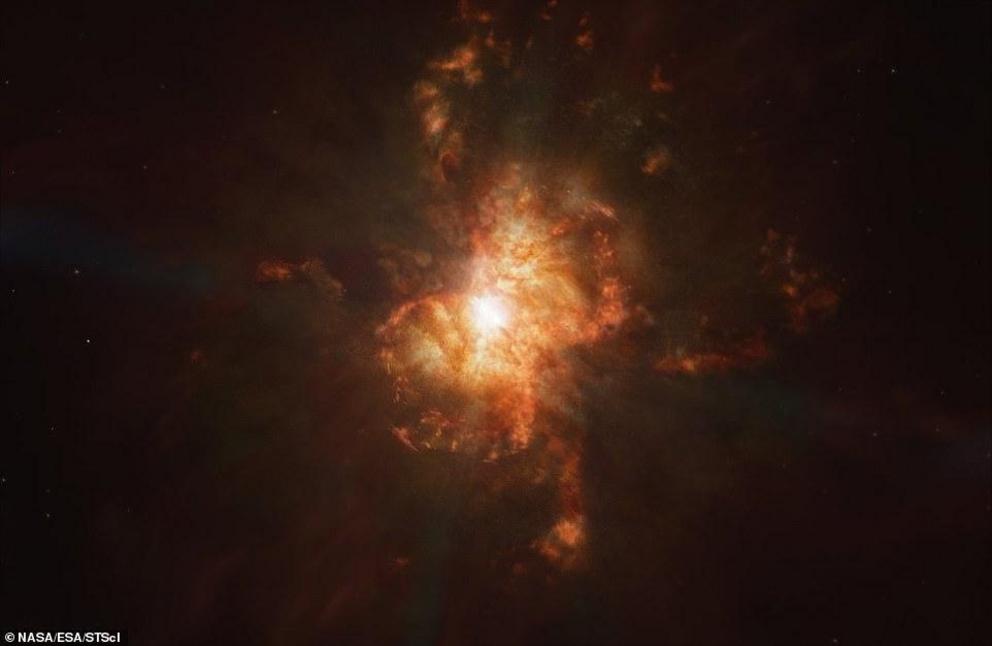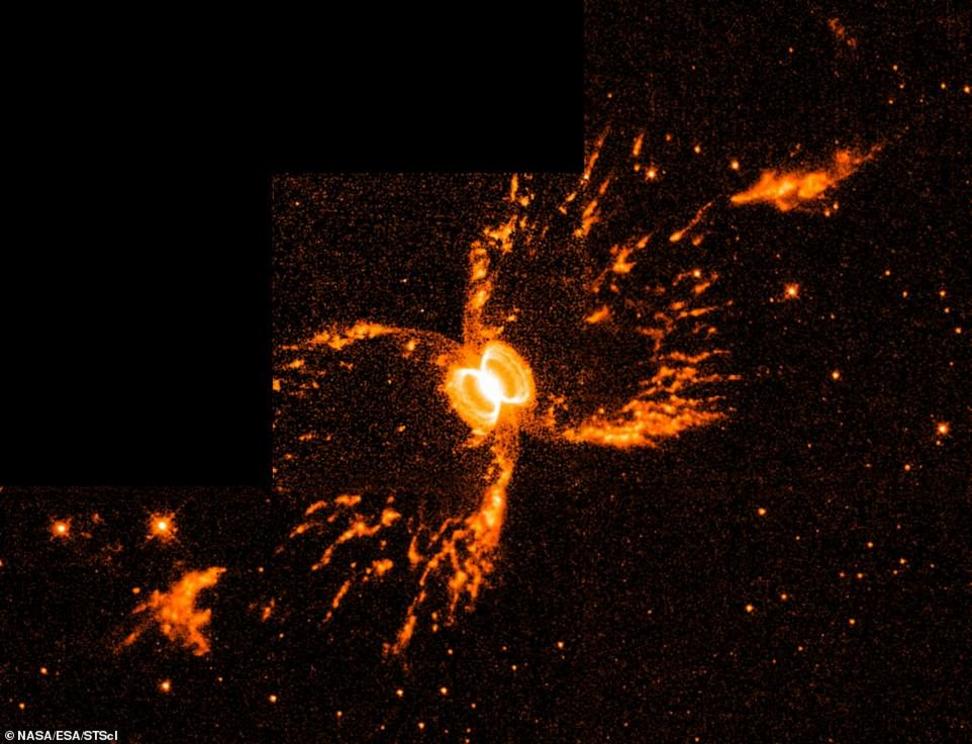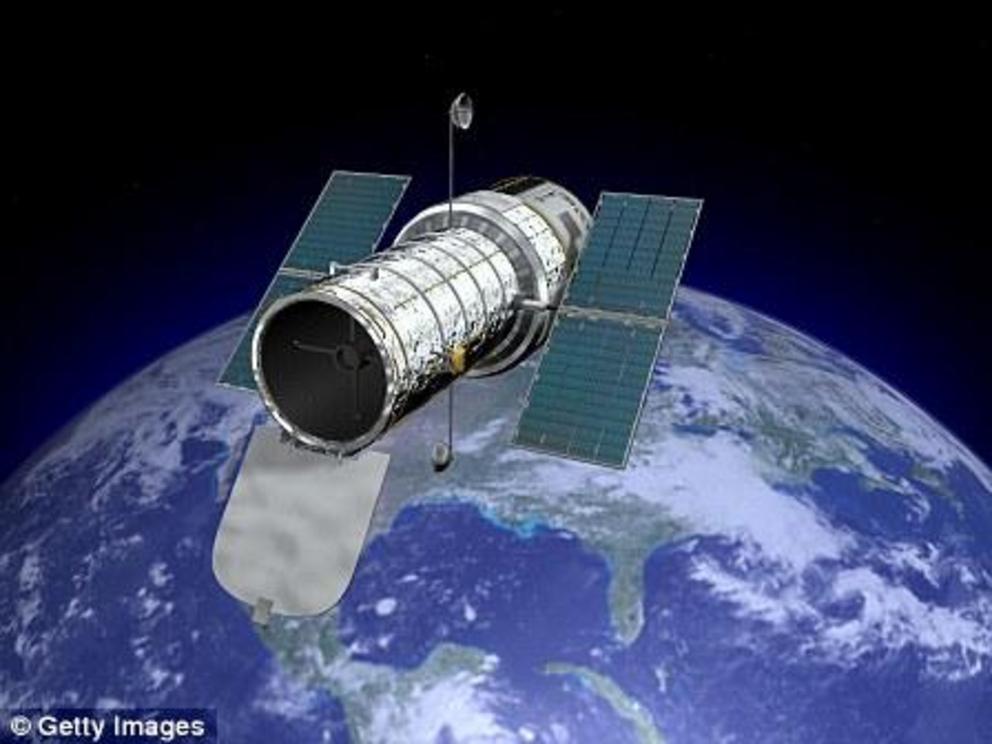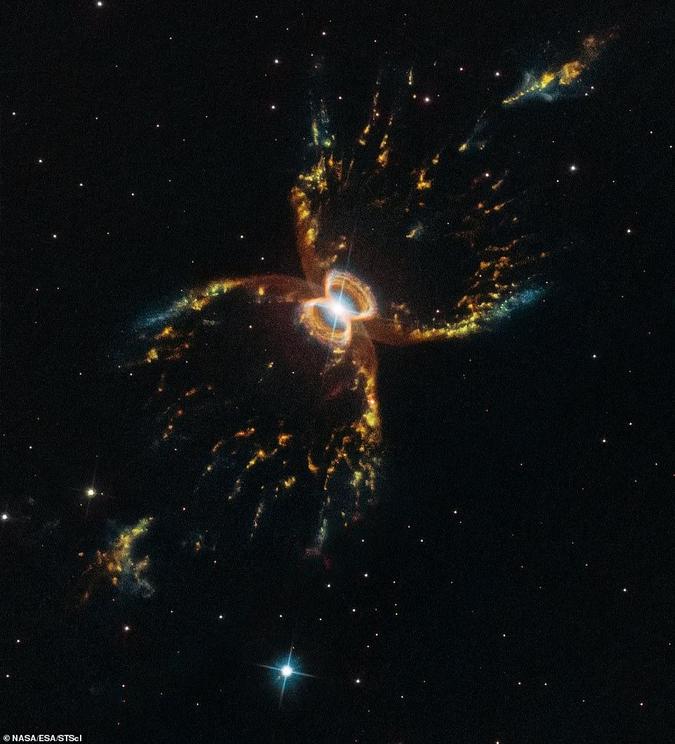Take a trip to the Southern Crab Nebula
NASA releases stunning images and immersive video of 'hourglass-shaped' star system from the Hubble Telescope in honor of its 29th anniversary
Take a trip to the Southern Crab Nebula: NASA releases stunning images and immersive video of 'hourglass-shaped' star system from the Hubble Telescope in honor of its 29th anniversary
- NASA has released stunning photos taken by the Hubble Space Telescope in honor of its 29th anniversary
- The photos show off the Southern Crab Nebula, located 7,000 light-years away, with its hourglass-like shape
- A red giant star and a white dwarf star sit at the center and continuously engage in a 'gravitational waltz'
- The red giant expels material that's absorbed by the white dwarf, giving it a peculiar crab leg-like shape
NASA has released new, breathtaking images of the Southern Crab Nebula in honor of the Hubble Space Telescope's upcoming 29th anniversary.
The Southern Crab Nebula, named after its resemblance to its northern counterpart the Crab Nebula, is distinctive due to its 'peculiar' hourglass-shaped structure, according to the European Space Agency (ESA).
A red giant star and a white dwarf star sit at the center of the nebula, forming a binary star system.
The images document in stunning detail how the red giant continuously expels material that's absorbed by the white dwarf, in what NASA described as a 'gravitational waltz,' that results in the hourglass-like shape.
NASA has released new, breathtaking images of the Southern Crab Nebula in honor of the Hubble Space Telescope's upcoming 29th anniversary. The Southern Crab Nebula gets its name from its resemblance to the northern Crab Nebula
As the stars continue on their celestial dance, whirling about, massive amounts of gas expand into space 'like a runaway hot air balloon,' according to NASA.
'When enough of this cast-off material is pulled onto the white dwarf, it too ejects the material outwards in an eruption, creating the structures we see in the nebula,' ESA explained.
'Eventually, the red giant will finish throwing off its outer layers, and stop feeding its white dwarf companion.
'Prior to this, there may also be more eruptions, creating even more intricate structures,' the agency added.
The brightest spots can be found at the edges of the nebula, where bubbles of gas and dust collect.
This gives the nebula the illusion of having 'crab legs,' with the glowing spots likely made up of hydrogen, sulfur, nitrogen and oxygen, NASA said.
The Southern Crab Nebula is located approximately 7,000 light-years away from Earth and is located in the constellation Centaurus.
Scientists can explain how it gets its peculiar crab leg-like shape, but this wasn't always the case, according to ESA.
The nebula was first documented in 1967, at which point scientists assumed that it was just an ordinary star.
However, when it was later observed in greater detail in 1989, they realized it exhibited a far more complex and distinctive hourglass formation.
 Above is an artist's impression of the formation of the Southern Crab Nebula, showing how it obtained its hourglass-like structure. The red giant sheds its outer layers in the last phase of its life before it too lives out its final years as a white dwarf
Above is an artist's impression of the formation of the Southern Crab Nebula, showing how it obtained its hourglass-like structure. The red giant sheds its outer layers in the last phase of its life before it too lives out its final years as a white dwarf
 Pictured is an image of the Southern Crab Nebula, taken by a Wide Field and Planetary Camera. Scientists didn't fully understand the intricate and distinctive structure of it until 1998, when Hubble shot its first images of the star system
Pictured is an image of the Southern Crab Nebula, taken by a Wide Field and Planetary Camera. Scientists didn't fully understand the intricate and distinctive structure of it until 1998, when Hubble shot its first images of the star system
It wasn't until nearly a decade later, in 1998, when the nebula first came into the view of Hubble, that scientists got their first full view of the Southern Crab's intricate structure.
'This image revealed the inner nested structures, suggesting that the phenomenon that created the outer bubbles had occurred twice in the (astronomically) recent past,' ESA said.
Now, more than a decade after Hubble first spotted the nebula, it has captured new images that show how the Southern Crab Nebula continues to evolve.
Of course, the human eye has no way of seeing this spectacular star formation without Hubble capturing it.
The eye-popping images are just one example of the kinds of interstellar phenomenons captured by Hubble since its inception.
Hubble was launched into orbit on April 24th, 1990, aboard space shuttle Discovery and was created as part of a partnership between NASA and the European Space Agency.
The telescope has scrutinized more than 43,500 celestial objects and racked up more than 1.5 million observations
In its 28-year lifetime, its circled Earth more than 163,500 times and traveled even farther than the distance from here to Pluto.
WHAT DOES THE HUBBLE SPACE TELESCOPE DO?
 The Hubble Space Telescope (pictured) recently captured a stunning image of a galaxy 20 million light years away
The Hubble Space Telescope (pictured) recently captured a stunning image of a galaxy 20 million light years away
The Hubble Space Telescope was launched jointly by NASA and the European Space Agency.
The Hubble is a space-based and long-term observatory.
The Hubble observes ultraviolet wavelengths, which the atmosphere filters out, and it collects visible light.
'The Hubble Space Telescope has made some of the most dramatic discoveries in the history of astronomy,' a statement on the Telescope says.
The machinery sits more than 370 miles above earth.
It can pick up on light via its 'eyes', which are five times more focused than ground-based telescopes.
The Hubble focuses on areas in deep outer space 'where some of the most profound mysteries are still buried in the mists of time'.
Hubble is still considered to be in good shape and officials have said that the telescope is likely to continue operating through 2020.
And its successor, the James Webb Space Telescope, is expected to launch by May 2020.
The James Webb telescope has been described as a 'time machine' that could help unravel the secrets of our universe.
The telescope will be used to look back to the first galaxies born in the early universe more than 13.5 billion years ago, and observe the sources of stars, exoplanets, and even the moons and planets of our solar system.
When it is launched, it will be the world's biggest and most powerful telescope, capable of peering back 200 million years after the Big Bang.

